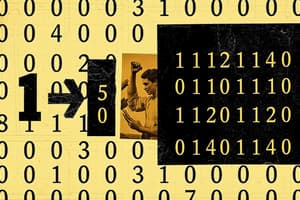Podcast
Questions and Answers
What is a common symbol used in binary representation?
What is a common symbol used in binary representation?
- 2 (correct)
- 3
- 7
- 5
When adding in binary, what happens if you run out of digits?
When adding in binary, what happens if you run out of digits?
- You add another bit to continue the addition
- You carry over the remaining digit to the final answer (correct)
- You add a 1 to the rightmost bit and continue
- You ignore the carry and stop adding
In binary addition, what is done when the sum exceeds two digits?
In binary addition, what is done when the sum exceeds two digits?
- The sum is discarded
- The sum is truncated to fit in a single digit
- A carry is generated to the next bit position (correct)
- The sum is divided by 2
What is the binary representation of the decimal number 10?
What is the binary representation of the decimal number 10?
In binary addition, what does it mean to 'Add with Carry'?
In binary addition, what does it mean to 'Add with Carry'?
When adding two binary numbers, what do we do if the sum is greater than 1 for a single bit?
When adding two binary numbers, what do we do if the sum is greater than 1 for a single bit?
What is the main difference between binary and decimal number systems?
What is the main difference between binary and decimal number systems?
Why is it necessary to have carry digits in binary addition?
Why is it necessary to have carry digits in binary addition?
What happens when you compute 1 + 1 in binary?
What happens when you compute 1 + 1 in binary?
Why do we represent the result of 10 as two separate digits in binary addition?
Why do we represent the result of 10 as two separate digits in binary addition?
What does the highest digit in binary represent?
What does the highest digit in binary represent?
Why do we need to be careful with carrying and borrowing in binary addition and subtraction?
Why do we need to be careful with carrying and borrowing in binary addition and subtraction?
What is the result of 25 - 123 using 8-bit 2’s complement?
What is the result of 25 - 123 using 8-bit 2’s complement?
What is the 1's complement of the subtrahend in the subtraction example provided?
What is the 1's complement of the subtrahend in the subtraction example provided?
Which rule of binary addition states '0 - 1 = 1 (borrow 1 from the more significant bit)'?
Which rule of binary addition states '0 - 1 = 1 (borrow 1 from the more significant bit)'?
What does 'No carry implies negative number' mean in binary arithmetic?
What does 'No carry implies negative number' mean in binary arithmetic?
How do we obtain the value after performing a binary subtraction when there is no carry?
How do we obtain the value after performing a binary subtraction when there is no carry?
What is the rule of binary multiplication stating '1 x 1 = 1 (no carry or borrow bits)'?
What is the rule of binary multiplication stating '1 x 1 = 1 (no carry or borrow bits)'?
Flashcards are hidden until you start studying
Study Notes
Binary Representation
- Non-negative integers are represented in Binary with Most Significant Bit (MSB) and Least Significant Bit (LSB)
- Binary representation uses only 2 symbols: 0 and 1
Binary Addition
- Binary addition is similar to decimal addition, but with 2 digits only (0 and 1)
- Carry and borrow rules apply, with careful handling of digits
- Example: 5 + 7 in binary form (1012 + 1112) with carry and borrow
Binary Subtraction
- Binary subtraction is similar to decimal subtraction
- Example: 25 - 123 using 8-bit 2's complement representation
Binary Arithmetic Rules
- Rules of Binary Addition:
- 0 + 0 = 0
- 0 + 1 = 1
- 1 + 0 = 1
- 1 + 1 = 0 (carry 1 to the next more significant bit)
- Rules of Binary Subtraction:
- 0 - 0 = 0
- 0 - 1 = 1 (borrow 1 from more significant bit)
- 1 - 0 = 1
- 1 - 1 = 0
- Rules of Binary Multiplication:
- 0 × 0 = 0
- 0 × 1 = 0
- 1 × 0 = 0
- 1 × 1 = 1 (no carry or borrow bits)
Binary Multiplication
- Binary multiplication follows the same process as decimal multiplication
- Multiply each digit of the second number by the first whole number, then add them, shifting each resulting multiplication one digit to the left.
Studying That Suits You
Use AI to generate personalized quizzes and flashcards to suit your learning preferences.




